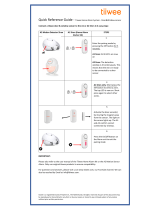
13
Siren
Siren does not respond to Key Pad
• Key Pad low battery or bad connection. Check
battery connections and polarity, if OK replace
battery.
• Siren batteries are completely exhausted. Check
Siren batteries by removing Siren cover, if there is
no tamper alarm when removed, replace batteries
with new alkaline equivalents.
• Key Pad not learnt-in. If Siren produces a tamper
alarm when the cover is removed, and Key Pad is
OK, learn-in the Key Pad.
• Siren could be out of radio range.
Siren produces a 3 second alarm when
disarmed
• There has been a previous alarm and there might
be an intruder still in the premises.
Siren produces a series of audible pips when
armed or disarmed
• If the Siren produces a series of pips when arming
and disarming this indicates low batteries.
• If the Siren produces a series of pips only when
arming this indicates a tamper fault. Check that
the Siren cover is firmly secured and the tamper
spring on the back of the Siren is fully depressed
when in contact with the wall. If not use suitable
packing material to fill the gap (refer to page 6 for
diagram).
Siren produces an interrupted tone when
sounding an alarm
• The Siren has low batteries. Change batteries with
new alkaline replacements (See page 11).
Key Pad
The Key Pad LED will not light when the Arm
key is pressed
• Battery is completely exhausted. Replace the
battery with new CR2032 coin cell battery (See
page 12).
The Key Pad LED will not work after battery
changes
• Battery has been inserted incorrectly and the
+ battery contact pin had been pressed to the side.
Check the battery compartment and ensure the +
battery pin stays above the battery.
The Siren will not respond to the disarm PIN code
• Ensure that the Key Pad mode is correct by
entering
test mode and pressing Panic Button “A” then “8”.
Forgotten user PIN code
• See “Key Pad reset procedure” on page 14.
PIR Motion Detector
PIR does not respond to motion
• Previous motion has triggered the PIR sleep timer
and is preventing subsequent motion detection.
Arm the system and vacate protected area for
at least 90 seconds before testing. By pressing
the learn/test button the PIR LED will light up and
detect motion for the first minute.
PIR Motion Detector is slow to respond
• This is normal, the PIR Motion Detector has
sophisticated false alarm filtering that will filter out
random fluctuations and responds to genuine
motion across field of view, it is less sensitive
walking directly towards it.
PIR Motion Detector gives false alarms
• Check pets have no access to the protected area.
• Check that the PIR Motion Detector is not pointed
at sources of heat or moving objects, e.g. fluttering
curtains.
• Check that the PIR Motion Detector is not
mounted above convector heaters or pointing
directly at windows.
Door/Window Contact
Door/Window Contact LED lights up
• Batteries are low or the tamper switch is disturbed.
Check that the tamper switch spring is making
contact with the mounting surface. If the tamper
switch is OK, change batteries with new alkaline
replacements (See page 11).
Door/Window Contact does not respond to
opening when jumper is in test position.
• Batteries are completely exhausted. Change the
battery (See page 11)
• The magnet is too far away from the Door/Window
Contact. Check that the gap between Door /
Window Contact and magnet is not greater than
10mm.
Troubleshooting
8
















